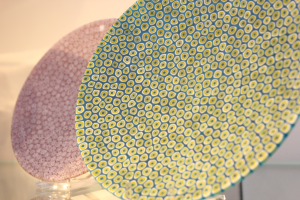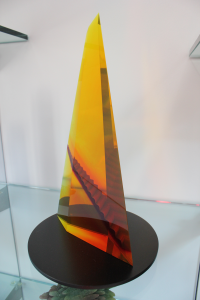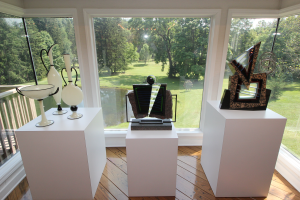Art expands a home’s horizons, and when selecting what to add to your house, art enthusiasts say to go with what you love
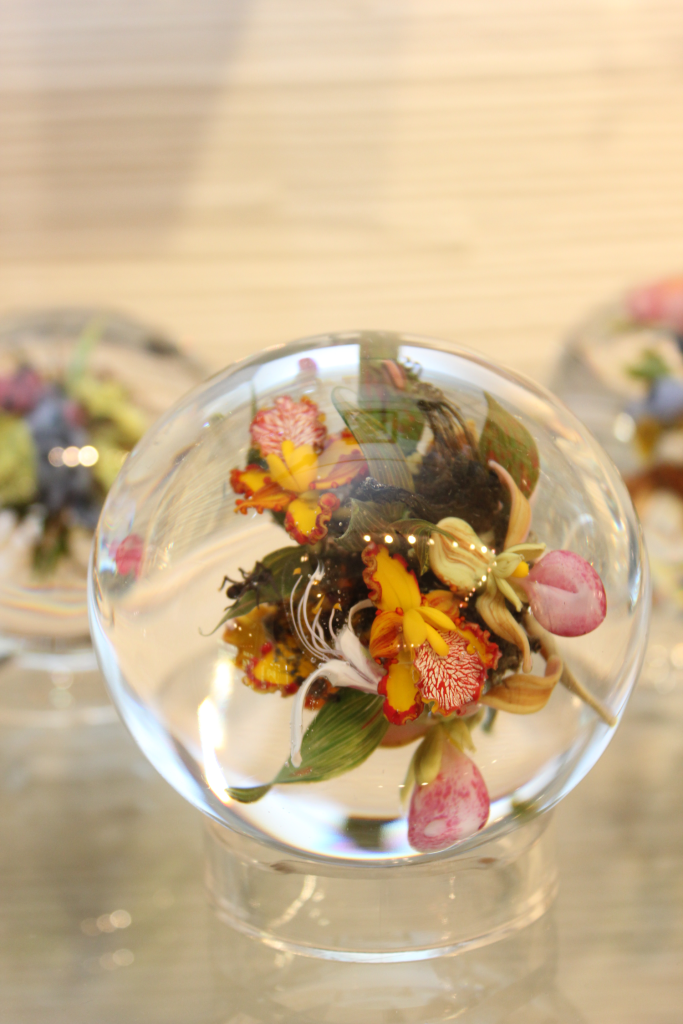
Paperweight bouquet with three pink orchids, three honeysuckles, one white flower, ant on leaf, bug on leaf, spirit underneath with ant and word cane on leaf by Paul J. Stankard, 2000 – part of Mike and Annie Belkin’s extensive art collection.
Story by Carlo Wolff
Photography by Michael C. Butz
In his play, “Back to Methuselah,” George Bernard Shaw may have characterized the personal value of art best: “You use a glass mirror to see your face; you use works of art to see your soul,” one character tells another.
That complicated maxim resonates with gallery owners, homeowners and art collectors alike. Seems no matter your position in the art field, art nurtures the soul — and enhances the home.
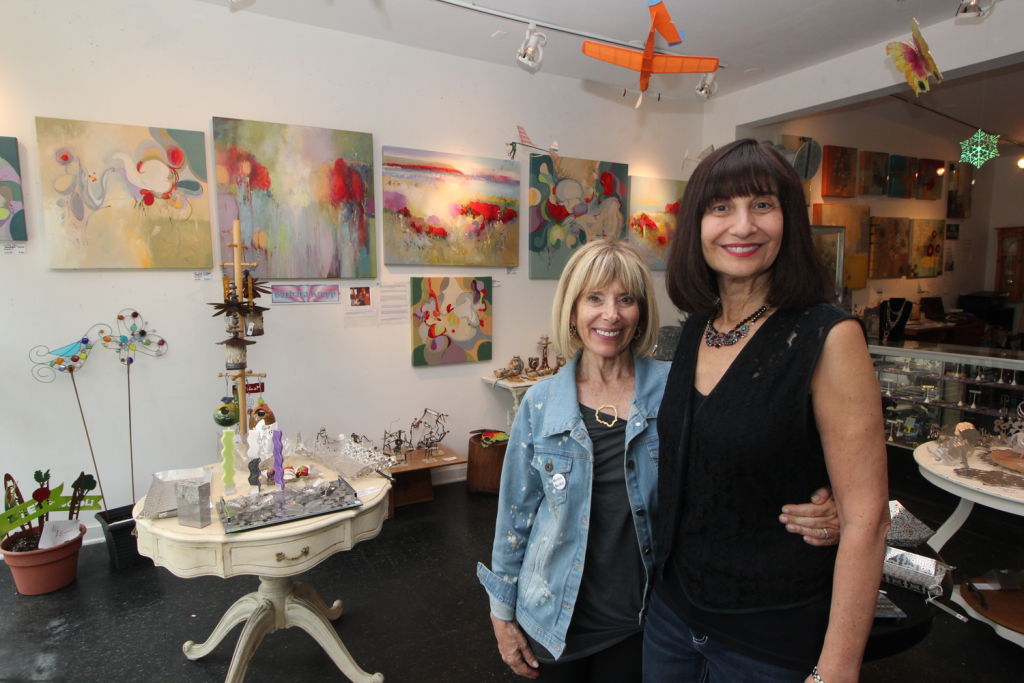
From left, Pennello Gallery co-owners Sue Cahn and Jacquie Meyerson inside their Little Italy gallery.
Take the views of Sue Cahn and Jacquie Meyerson, who, with partner Howard Koverman, own Pennello Gallery in Cleveland’s Little Italy district. Pennello, which is Italian for “paint brush,” sells conventional, even functional art, along with imaginative Judaica, like portable, chain-link menorahs, silver dreidels and ornamental silver mezuzahs. The window display in the wraparound storefront Pennello has occupied for the past 10 years is inviting indeed.
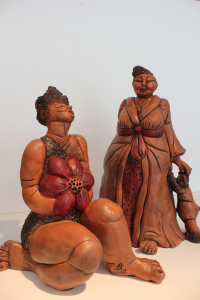
“Fleur d’Alose” and “Beautiful Bev with Bow Wow,” clay sculptures from Cynthia Polster’s “Women of Significance” series.
“Art makes our home a home,” says Cahn. “It adds color, it adds focal points, it adds interest, it adds beauty.” Meyerson, who often caps Cahn’s sentences (and vice versa), says “it can add serenity.”
Art can occupy its own space; it can be standalone, Cahn suggests.
“A lot of people don’t understand that it doesn’t have to match the furniture,” she says. “You purchase art because you love it.” Is art therapeutic? “Extremely. You sit in your house and look around the room and it can be very calming.”
Meyerson elaborates, “Every piece of art will evoke emotions that a viewer brings to the piece.” It can be thought-provoking, too, like Cynthia Polster’s “Women of Significance” series of voluptuous, earthy figures.
“It also brings comedy into the home,” says Cahn. “Many of our pieces are very whimsical.”
Particularly amusing examples are papier mâché sculptures of a weightlifter in full extension and of a reporter with cameras around his waist, pencil behind his ear (how retro). They’re made by artist Naava Naslavsky, an Israeli native and a microbiology researcher who lives in Omaha. They bring a smile to one’s face.
The gallery also offers singular bridal gifts “that will carry a couple through their lives,” says Cahn. “It’s not just dishes.” What Pennello’s customers — many connected to the nearby Cleveland Clinic, University Hospitals and Case Western Reserve University — seek is “something different and unusual that’s handmade, not made in a factory in China,” adds Meyerson. All Pennello’s offerings are made in the U.S., Canada or Israel.
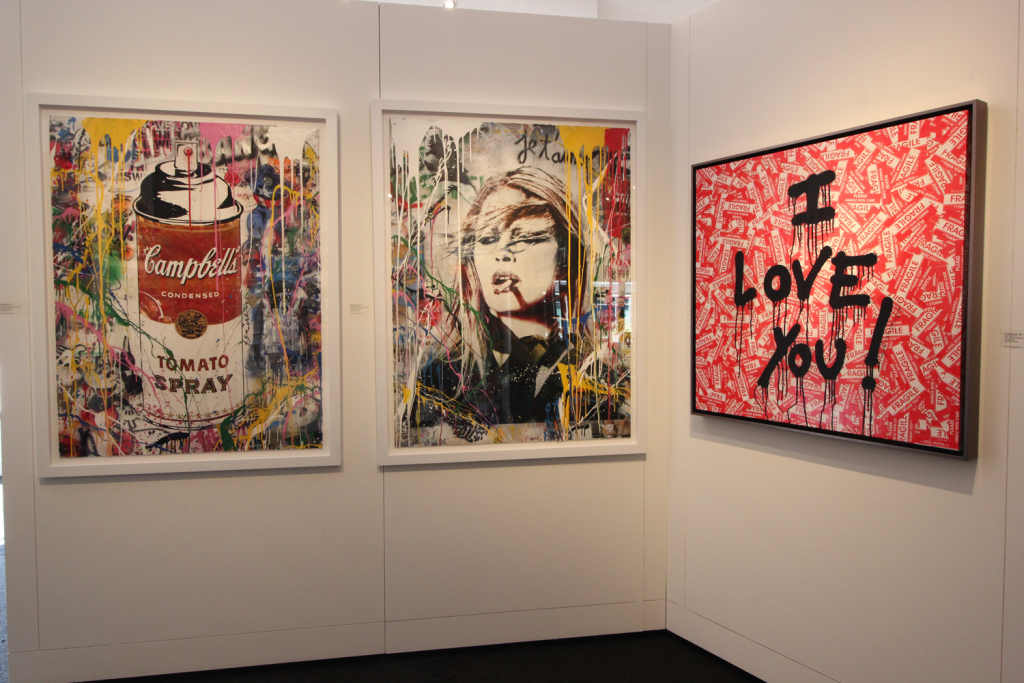
Examples of art available at Contessa Gallery in Lyndhurst are “Tomato Spray” by Mr. Brainwash, 2017, silkscreen and mixed media on paper, 50 inches by 38 inches unframed; “Brigitte Bardot” by Mr. Brainwash, 2017, silkscreen and mixed media on paper, 50 inches by 38 inches unframed.

Silkscreen and mixed media on paper, 50 inches by 38 inches unframed; “I Love You!” by Mr. Brainwash, 2016, spray paint and stickers on plywood, 36 inches by 36 inches; “Dream as One” by Craig Alan, 2017, acrylic painting on canvas, 60 inches by 48 inches.
Not only does art express the artist, it also expresses the person who buys it and displays it, says Steve Hartman, who, along with Karen Tscherne, owns Contessa Gallery in Lyndhurst.
“For many people, art is the highest form of personal communication of what they value, what influences them, how it makes people feel,” he says. “To surround yourself with things that are stimulating you, whether it’s a physical response, emotional response or spiritual response, I think is something that affects people at their truest core.”
Hartman, whose Legacy Village gallery is oriented toward collectors like himself, suggests that while art can be relaxing, it also can increase productivity, leading art lovers to “think in a different way to enhance their brain waves to activate creativity.” Each work of art can elicit a different response, “some more emotional, some more intellectual,” he says. And every owner “has a unique relationship with each piece of art.”
“I think that, again, art is very possibly the highest form of personal expression, and for that reason, it really helps people to connect with the world and themselves,” says Hartman, who launched Contessa in 1999. “Some artists and some people look at art almost as seeing a self-portrait in a way even if it’s something abstract. … Some people see a self-portrait in every work with which they engage because everybody sees, feels and reacts differently.”
So art is both mirror and self-validation? Yes, says Hartman, “because engaging art is what it is like to express oneself and to get inside oneself as to how it makes one feel about the world. That’s why it is that mirror and self-portrait.”
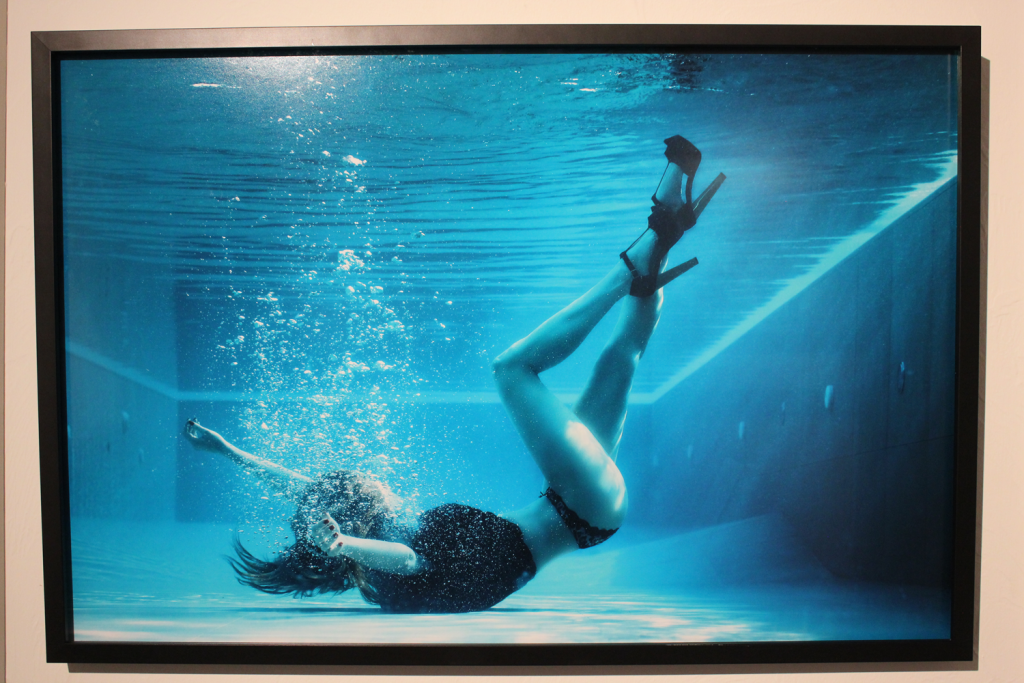
“Below the Surface” by David Drebin, 2013, digital print, 20 inches by 30 inches.
Art also is about surrounding yourself with unique works of the imagination. Let’s visit a home that’s a virtual gallery in itself.
Mike and Annie Belkin collect art, particularly contemporary art glass. Their home in rural Geauga County is awash with glass, paintings and sculpture on all three floors, from the whimsical ceramics Annie favors to the glass Mike has been amassing — and the couple have donated to museums — over the past nearly 50 years.
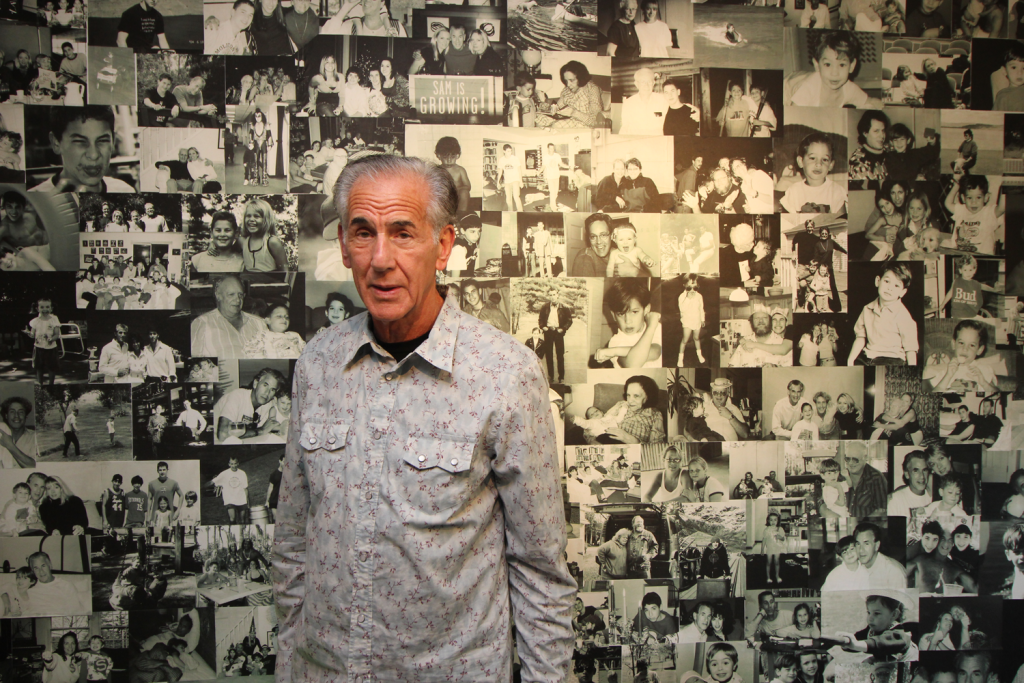
Art collector Mike Belkin in front of a wall-sized photo collage his wife, Annie, assembed. The collage, located on the lower level of the couple’s Geauga County home, includes pictures of familly and friends.
Mike Belkin, who may be known best for Belkin Productions, the rock ’n’ roll juggernaut he founded with his brother, Jules, in 1966, explained what art means to him and how it enhances his feeling of home. Art has characterized his home in Russell Township since he moved there in the mid-’70s.
Over those decades, Belkin has acquired striking modern, and deeply artistic, furniture; limited-edition books on art and artists, rock ’n’ roll and popular culture; watches; and his latest craze, coins.
Belkin began by collecting antique paperweights and beaded purses, branching out into Tiffany glass, modern paintings and drawings and, most importantly, contemporary art glass by the likes of Dale Chihuly, Steven Weinberg, William Carlson and Paul Stankard. An old-fashioned patron of the arts, he has commissioned work by some of those artists.
- Murano plates given to the Belkins as gifts from artist William Carlson.
- “Escher’s Tower” by Mark Peiser, 1986, cast glass form with staircase interior.
- From left, “Ivory and Black” by Dante Marioni, 1996, three-part blown glass group; “Vetro Muralis” and “Contrapuntal,” both sculptures by William Carlson.
“Beauty is very important,” Belkin says, “because I like it, I like beautiful things, and I like the craftsmanship involved, I appreciate that.” As he walks through his house, he points to a Weinberg that’s part prism, part wheel, altogether magic. “I love art, especially glass art,” Belkin says. “I appreciate the beauty and beautiful objects. People who create, whether it be art or music, people who are creative and do all these things that I can’t do.”
The Belkins often acquire art in their travels, attending seminal shows such as Art Basel in Miami. They also often become friends with artists they particularly enjoy.
What advice would Belkin give the beginning art collector? Go with your gut. Art appreciation — and collection — start with “a feeling in your heart, which will transfer to your brain,” he says. “It’s a desire to own it and live with it – hopefully.”
And if that attachment outstays its welcome, don’t be afraid to turn over your collection. Over the years, Belkin has sold art, sometimes even at a loss, to raise cash for a new work he wants to introduce to his household.
Still, there are pieces he would never sell. “It’s not my business buying and selling art,” says Belkin, noting he developed his artistic tastes on his own, largely by going to art exhibitions and art auctions. His business is sports merchandising and selling tickets to rock shows. Art, for him, is above all a pleasure. js

